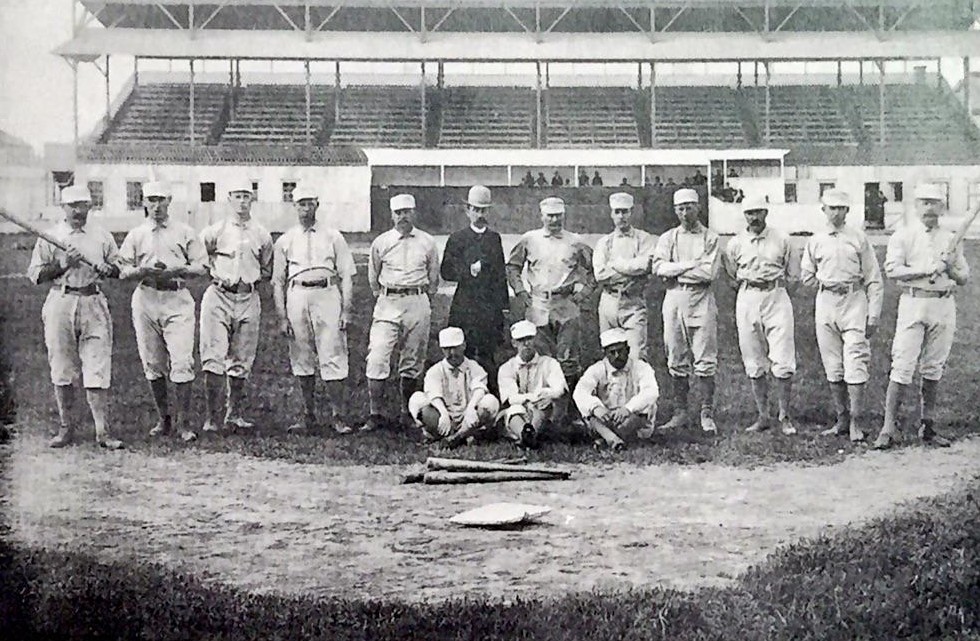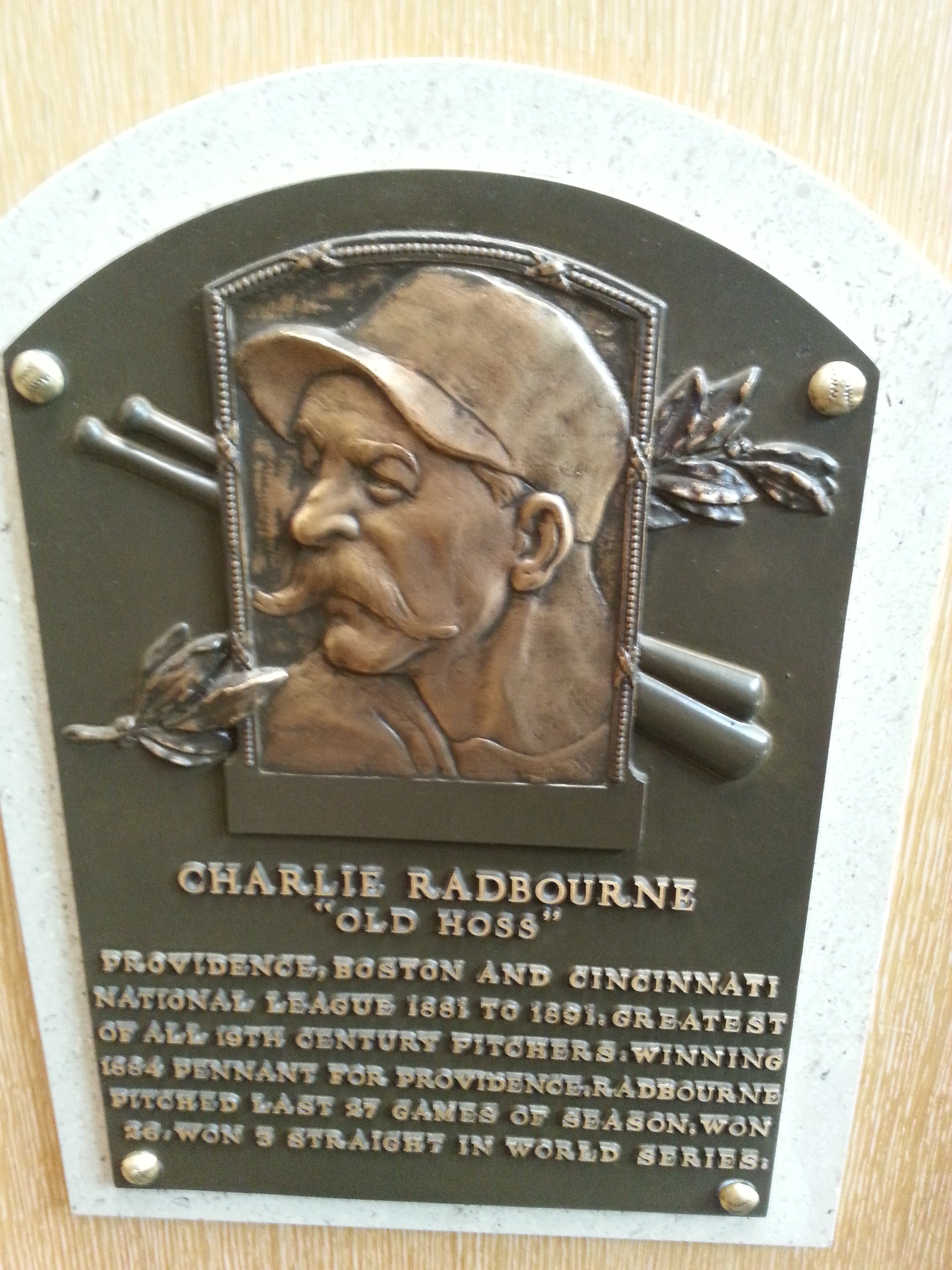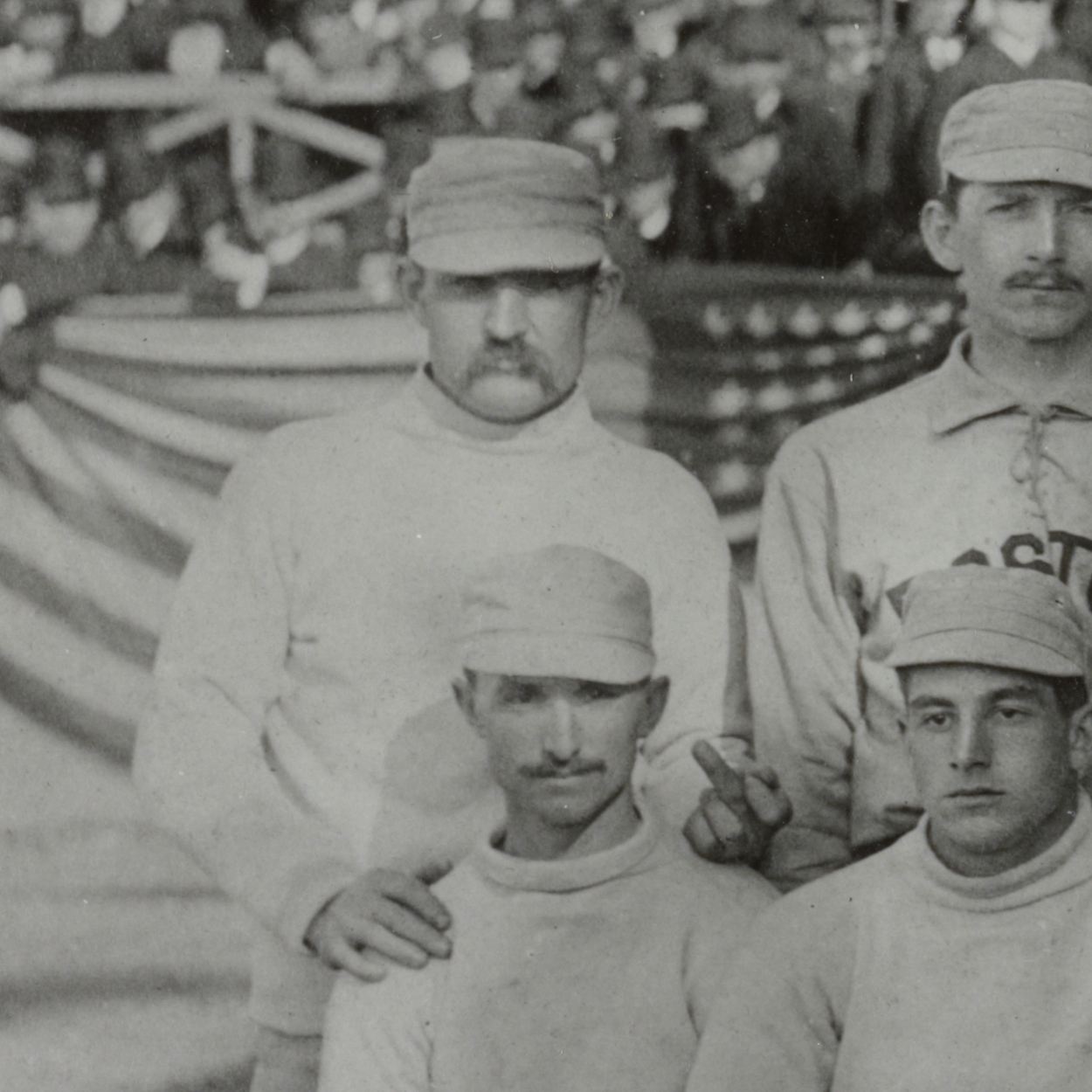1. Overview
Charles Gardner Radbourn, often known by his nickname "Old Hoss", was an American professional baseball pitcher who played 12 seasons in Major League Baseball (MLB) from 1880 to 1891. He is widely recognized for his record-setting 1884 season with the Providence Grays, during which he achieved an unprecedented 60 wins, a single-season MLB record that remains unbroken. In that same year, he won the Triple Crown by leading the National League in wins, ERA, and strikeouts. Radbourn also contributed significantly to the Grays' victory in the 1884 World Series. His career saw him amass 310 wins, making him one of the most dominant pitchers of his era. In 1939, he was posthumously inducted into the National Baseball Hall of Fame.
2. Early Life and Background
Charles Radbourn's early life and background set the stage for his eventual rise to baseball prominence, shaped by his family's immigrant journey and his formative years in Illinois.
2.1. Childhood and Family
Charles Gardner Radbourn was born on December 11, 1854, in Rochester, New York. He was the second of eight children born to Charles and Caroline (Gardner) Radbourn. His father, Charles Radbourn Sr., had immigrated to the United States from Bristol, England, seeking work as a butcher, with Caroline following shortly thereafter. In 1855, his family relocated to Bloomington, Illinois, where Radbourn spent his formative years. As a teenager, he worked alongside his father as a butcher and also held a job as a brakeman for the Indiana, Bloomington and Western Railway company before embarking on his professional baseball career.
3. Baseball Career
Radbourn's baseball career began in the semi-professional ranks and saw him develop from a versatile position player into one of the most dominant pitchers of the 19th century, especially during his impactful tenure with the Providence Grays.
3.1. Early Career
Radbourn began his baseball career in 1878, joining the Peoria Reds, a barnstorming team. With the Reds, he primarily played as a right fielder but also served as a "change pitcher." In the baseball rules of the era, substitutions were not allowed, meaning a "change pitcher" would typically play another position, like right field, and swap places with the starting pitcher if the starter became ineffective in later innings, aiming to secure a victory. In 1879, he signed with Dubuque in the newly formed Northwest League.
His major league debut came in 1880 with the Buffalo Bisons of the National League. During his time with Buffalo, he played in six games, primarily as a second baseman and right fielder. He struggled at the plate, batting only .143, and did not pitch an inning. His strenuous practice regimen led to a sore shoulder, and he was subsequently released by the team. After recovering from his shoulder injury, Radbourn pitched for a local Bloomington team in an exhibition game against the Providence Grays. His impressive performance in that game caught the attention of the Grays, who promptly signed him for a salary reported to be between 1.10 K USD and 1.40 K USD.
3.2. Providence Grays Era
Radbourn's time with the Providence Grays marked the most significant period of his career, during which he established himself as a dominant force in baseball, culminating in his historic 1884 season.
3.2.1. Early Years with the Grays (1881-1883)
In his inaugural season with the Providence Grays in 1881, Radbourn shared pitching duties with John Montgomery Ward. He pitched 325.1 innings and recorded a win-loss record of 25-11. By 1882, he had solidified his role as the team's primary pitcher, logging 466 innings with a 33-19 record and a 2.11 ERA. That year, he led the National League with 201 strikeouts and six shutouts, while also ranking second in wins and ERA.
His performance continued to improve in 1883, when he pitched an astounding 632.1 innings, leading the league with 48 wins against 25 losses. Despite the lifting of the underhand pitching restriction between 1883 and 1884, Radbourn consistently employed a submarine pitching style. His 2.05 ERA and 315 strikeouts in 1883 both ranked second in the National League.
3.2.2. The 1884 Record-Setting Season

The 1884 season was the most remarkable of Radbourn's career and in baseball history. Facing financial instability after failing to win the pennant in 1883, the Providence Grays' ownership brought in new manager Frank Bancroft with a clear mandate: win the pennant or the team would be disbanded.
Early in the season, Radbourn shared pitching responsibilities with Charlie Sweeney. Radbourn, known for his vanity, grew increasingly jealous as Sweeney began to achieve greater success. This tension escalated into a violent altercation in the clubhouse. Radbourn was deemed the aggressor and was suspended without pay after a poor outing on July 16, amidst accusations that he deliberately lost the game by throwing soft pitches. The team's situation worsened on July 22 when Sweeney, intoxicated, was ejected from a game and left the park, leaving the Grays with only eight players. With a depleted roster unable to cover all three outfield positions, Providence lost the game.
With Sweeney off the team, the Grays were in disarray, and many believed the team should be disbanded. At this critical juncture, Radbourn made an extraordinary offer: he would start every game for the remainder of the season in exchange for a small salary raise and an exemption from the reserve clause for the following season. This was a significant commitment, as he had pitched in 76 of 98 games the previous season. From July 23 until the pennant was clinched on September 24, Radbourn started 40 of Providence's 43 games, winning 36 of them. He was pitching nearly every other day, and his arm became so sore that he struggled to even comb his hair. On game days, he would arrive at the ballpark hours early for an extensive warm-up routine, starting with short tosses and gradually increasing the distance until he was pitching from second base and even short center field.
Radbourn concluded the 1884 season with an astounding 678.2 innings pitched and 73 complete games. He achieved the Pitching Triple Crown by leading the league in wins (60-12), earned run average (1.38 ERA), and strikeouts (441). His 60 wins in a single season is an MLB record that is widely considered unbreakable, as no modern starting pitcher has made more than 37 starts in a season since Greg Maddux in 1991. Radbourn's 678.2 innings pitched also ranks second all-time for a single season, just behind Will White's 680 innings in 1879. Beyond the Triple Crown, he also led the league in win percentage and saves (though the definition of saves was different at the time), making him the first pitcher to lead in five major statistical categories.
After the regular season, the National League champion Grays faced the American Association champions, the New York Metropolitans, in the 1884 World Series. Radbourn pitched every inning of all three games, winning each one while allowing only three unearned runs.
3.2.3. Statistical Notes and Win Controversy

There is a historical debate surrounding Charles Radbourn's exact win total in the 1884 season. While widely recognized as 60 wins, some sources list it as 59, and older records even suggested as high as 62. The discrepancy primarily stems from the different scoring rules prevalent in the early years of baseball compared to modern regulations, which allowed official scorers more latitude in assigning wins.
For instance, in a game on July 28 against Philadelphia, Cyclone Miller pitched five innings and left with his team trailing 4-3. Providence then scored four runs in the top of the sixth inning. Radbourn entered the game in relief and pitched four shutout innings, securing an 11-4 victory for the Grays. Under the rules of the day, the official scorer awarded the win to Radbourn, deeming him the most effective pitcher. However, under modern scoring rules, Miller would be credited with the win as the "pitcher of record" when he left the game with a lead, and Radbourn would have been credited with a save for his effective relief pitching of three or more innings. Consequently, some modern statistical analyses retroactively assign that win to Miller, resulting in a 59-win total for Radbourn for the season. Despite these debates, the historical record generally credits him with 60 wins.
3.2.4. Transition from the Grays (1885)
In 1885, Radbourn continued to pitch effectively, though he was unable to replicate the extraordinary success of his 1883 and 1884 seasons. He pitched 445.2 innings and finished with a 28-21 win-loss record. Following the season, the Providence Grays franchise disbanded due to financial difficulties. As a result, their roster was transferred to the control of the National League.
3.3. Later Career and Retirement
After the Providence Grays folded, Radbourn was claimed by a Boston National League team, where he spent the next four seasons. During this period, he recorded win totals of 27, 24, 7, and 20 games. His career with the Boston team saw him continue to be a significant pitcher, although in 1887, he led the league in both earned runs and walks, recording a relatively high 4.55 ERA for the season.
In 1890, Radbourn jumped to the Players' League, a short-lived rival major league, and played for its Boston club. After the Players' League folded following that single season, he played his final major league year in 1891 with the Cincinnati Reds. During his stint with the Reds, Radbourn achieved his 300th career victory before retiring from professional baseball at the end of the season. His final career record stands at 310 wins against 194 losses, with a career ERA of 2.68 ERA and 1,830 strikeouts.
Radbourn's pitch repertoire reportedly included a "rising fastball" (a fast pitch with an upward movement), a "dry spitball" (a pitch that moved like a knuckleball), a "slow changeup," a "fadeaway" (similar to a screwball), and a "sinker."
| Year | Team | G | GS | CG | SHO | W | L | PCT | BF | IP | H | HR | BB | K | R | ER | ERA | WHIP | |
|---|---|---|---|---|---|---|---|---|---|---|---|---|---|---|---|---|---|---|---|
| 1881 | Providence Grays | 41 | 36 | 34 | 3 | 25 | 11 | .694 | 1380 | 325.1 | 309 | 1 | 64 | 117 | 162 | 88 | 2.43 | 1.15 | |
| 1882 | Providence Grays | 54 | 51 | 50 | 6 | 33 | 19 | .635 | 1916 | 466.0 | 422 | 6 | 51 | 201 | 213 | 109 | 2.11 | 1.02 | |
| 1883 | Providence Grays | 76 | 68 | 66 | 4 | 48 | 25 | .658 | 2540 | 632.1 | 563 | 7 | 56 | 315 | 275 | 144 | 2.05 | 0.98 | |
| 1884 | Providence Grays | 75 | 73 | 73 | 11 | 60 | 12 | .831 | 2672 | 678.2 | 528 | 18 | 98 | 441 | 216 | 104 | 1.38 | 0.92 | |
| 1885 | Providence Grays | 49 | 49 | 49 | 2 | 28 | 21 | .571 | 1841 | 445.2 | 423 | 4 | 83 | 154 | 209 | 109 | 2.20 | 1.14 | |
| 1886 | Boston (NL) | 58 | 58 | 57 | 3 | 27 | 31 | .466 | 2162 | 509.1 | 521 | 18 | 111 | 218 | 300 | 170 | 3.00 | 1.24 | |
| 1887 | Boston (NL) | 50 | 50 | 48 | 1 | 24 | 23 | .511 | 1915 | 425.0 | 505 | 21 | 133 | 87 | 20 | 305 | 215 | 4.55 | 1.50 |
| 1888 | Boston (NL) | 24 | 24 | 24 | 1 | 7 | 16 | .304 | 852 | 207.0 | 187 | 8 | 45 | 64 | 110 | 66 | 2.87 | 1.12 | |
| 1889 | Boston (NL) | 33 | 31 | 28 | 1 | 20 | 11 | .645 | 1180 | 277.0 | 282 | 14 | 72 | 99 | 151 | 113 | 3.67 | 1.28 | |
| 1890 | Boston (PL) | 41 | 38 | 36 | 1 | 27 | 12 | .692 | 1497 | 343.0 | 352 | 8 | 100 | 80 | 183 | 126 | 3.31 | 1.32 | |
| 1891 | Cincinnati Reds | 26 | 24 | 23 | 2 | 11 | 13 | .458 | 963 | 218.0 | 236 | 13 | 62 | 54 | 149 | 103 | 4.25 | 1.37 | |
| Career (11 years) | 527 | 502 | 488 | 35 | 310 | 194 | .614 | 18918 | 4527.1 | 4328 | 118 | 875 | 1830 | 2273 | 1347 | 2.68 | 1.15 | ||
4. Post-Retirement Life and Death
After concluding his distinguished baseball career, Charles Radbourn embarked on new ventures, but his post-retirement life was marked by a serious accident and an early death.
Following his retirement from baseball, Radbourn established a successful billiard parlor and saloon in his hometown of Bloomington, Illinois. However, a significant hunting accident occurred soon after his retirement, which resulted in the loss of one of his eyes. Charles Gardner Radbourn died in Bloomington, Illinois, on February 5, 1897, at the age of 42. His death was attributed to complications arising from syphilis. He was interred in Evergreen Cemetery in Bloomington.
5. Legacy and Influence
Charles Radbourn's impact on baseball history is profound, marked by his unparalleled achievements on the mound and his intriguing connection to cultural anecdotes.
5.1. Baseball Achievements and Recognition
Radbourn's numerous achievements and records solidified his place in baseball history. He was posthumously inducted into the Baseball Hall of Fame in 1939, a testament to his dominant career. In 1941, a plaque detailing his distinguished career was placed on the back of his elaborate headstone.
Among his many accolades, Radbourn holds the major league record for most wins in a single season with 60 in 1884. He led the National League in wins twice (1883, 1884), ERA once (1884, 1.38 ERA), and strikeouts twice (1882, 1884). His 1884 season uniquely saw him claim the Pitching Triple Crown. He also led the league in saves in 1884, making him the first pitcher to lead in five major statistical categories (wins, win rate, ERA, strikeouts, saves). His career total of 310 wins and 489 complete games places him among the all-time leaders in these categories, with his complete games ranking 8th all-time. In the 2001 book The New Bill James Historical Baseball Abstract, baseball historian Bill James ranked Radbourn as the 45th-greatest pitcher of all time.
5.2. Cultural Anecdotes and Historical Significance

Beyond his on-field prowess, Charles Radbourn is associated with several interesting cultural anecdotes. It is widely speculated that the term "charley horse", referring to a painful leg cramp, derives its name from Radbourn. He frequently suffered from such cramps during his playing days. While the term originated during his time in baseball and was often linked to players experiencing this "new disease," it is thought that "Charley" was a common name for horses, and the term referred to the stiff-leggedness characteristic of the condition, similar to a horse.
Radbourn is also notable for being the subject of the earliest known photograph featuring the gesture of "the middle finger". This image was captured in 1886, showing him "flipping off" a member of the New York Giants in a team photograph.